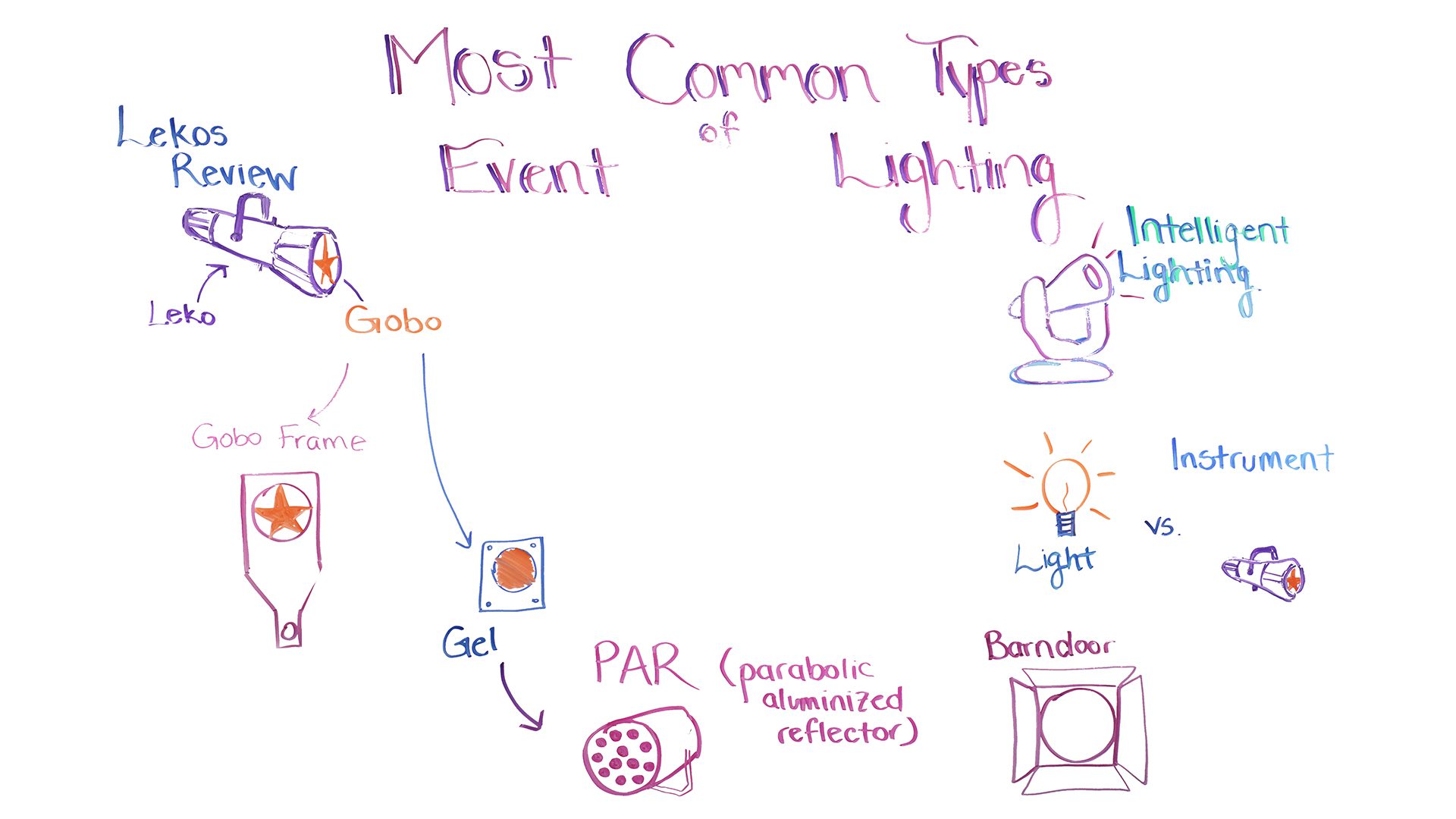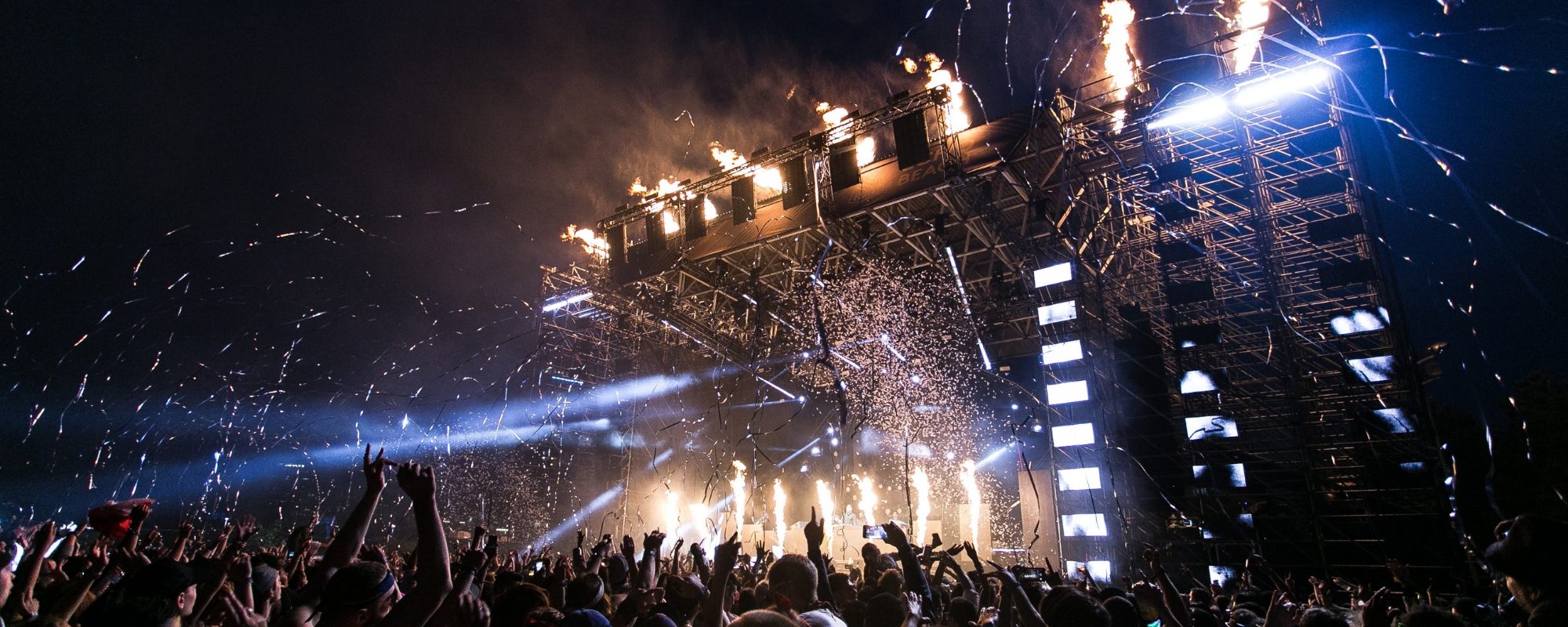Event lighting can make or break your event. If you get the wrong types it may not serve the purpose you were hoping for, set the wrong mood, and much more. But when you see event lighting on an AV quote the terms might sound like another language.
That stops today! In this episode of Whiteboard Wednesday, Brandt Krueger of Event Technology Consulting will be guiding you through the 4 most common types of event lighting and how they apply to your event design.
 What Are The Most Common Types of Event Lighting?
What Are The Most Common Types of Event Lighting?
Lekos are Highly Adjustable Lights
Brandt explains the following attributes of Leko lights:
- Lekos are the long and skinny lights with a little barrel on the front end,
- they are highly adjustable (you can adjust the focus or put Gobos in them),
- it can create smooth transitions from soft to more focused light,
- the shutters can block out a part of the light to highlight a certain space.
PAR (Parabolic Aluminized Reflector)
A PAR comes with a different set of perks.
- shorter and rounded in the back,
- they can blast a light,
- it’s a nice and fuzzy light
- it is used for stage washes.
Leko Use VS PAR Use
Use Leko when you want to focus in on something and highlight it. PARs, on the other hand, are instruments that you can use where you want to do stage washes. You want to just light up the whole stage and it doesn’t really matter how much it spills.
You can actually adjust PAR a little by using a barn door. This is the brute force of focusing light. It’s literally little foldy wings that you can put on the front end of the light to physically block off that light. You see those when you look at television studios. You’ll see these big giant barn door things sitting on the front of the instruments.
Most Common Types of Event Lighting: Put A Gel On
PARs and Lekos have something in common: you can put a gel in the front of them. This is how we change colors in stage lighting, theatrical lighting, and event lighting.
All of that has started to change as we’ve started to deal with LED lighting. We’re using LED lighting to be able to change the lighting on the fly.
LED: Lights and Instruments
So in the lighting world, there’s a difference between a light and an instrument. The light is the physical light bulb that’s being used in the instrument. And the instrument refers to the type of housing.
Aas LEDs have become more popular, cheaper, and brighter, they’re starting to use LED lights inside various different types of instruments. So you can have an LED Leko versus the old incandescent bulb Lekos. You can have an LED PAR versus the old incandescent bulbs.
Lekos and PARs in LED instruments save power. LED uses far less power than the old incandescent bulbs. So, you’re actually able to save a lot of power. You can use more of these lights in an area without blowing the circuit. So you’re able to actually get more of these lights all on the same circuits without overloading it.
By using LEDs in these, you don’t have to deal with gels. So you’re actually able to change the color on the fly, just like we can do now in our houses with Phillips Hue Bulbs. Rather than having to go up on a ladder and change lights manually, you can actually just go in through the light board controller and change the color that’s coming out of those instruments.
Intelligent Lighting
Intelligent lighting has the capability of having Gobos in them. The Gobos is, that’s the something where, again, Will kind of talked about in his Whiteboard Wednesday where you can just take a little pattern or an image and you can put that in the top of the Leko, and then it shines through, and projects that image down there. So you can have Gobos in there, they can have shutters in there, you can have the ability to change the color of the light, and you have the ability to move the light. All depending on basically how expensive the lighting is. So there are lights that can do all of that and there’s some that are more like DJ-oriented where they just swivel and move to the music or something along those lines.
So there really is an enormous range of what we can consider Intelligent Lighting. But just know that that’s kind of that next level of lighting. And the good news is that the cost is starting to come down on those as well. So we’re starting to see pretty reasonably priced options for moving head instruments that can do all the basics of changing color, maybe change the size and shape of the thing of the light beam that’s coming down, and perhaps even bring in patterns and Gobos adjustments and that. Those are the most common types of event lighting.
Most Common Types Of Event Lighting: Conclusions
The easiest thing to remember is that if you’re just doing a stage wash, what you want is a PAR. If you need to be able to focus in on something, you need a Leko. If you need to be able to project a gobo or a pattern, you need a Leko. When you want to move lights and change the color, that’s where we’re getting into the Intelligent Lighting.
These are the most common types of event lighting, but there are many others on the market.
Thank you so much for watching, we’ll see you next time on Whiteboard Wednesdays.









